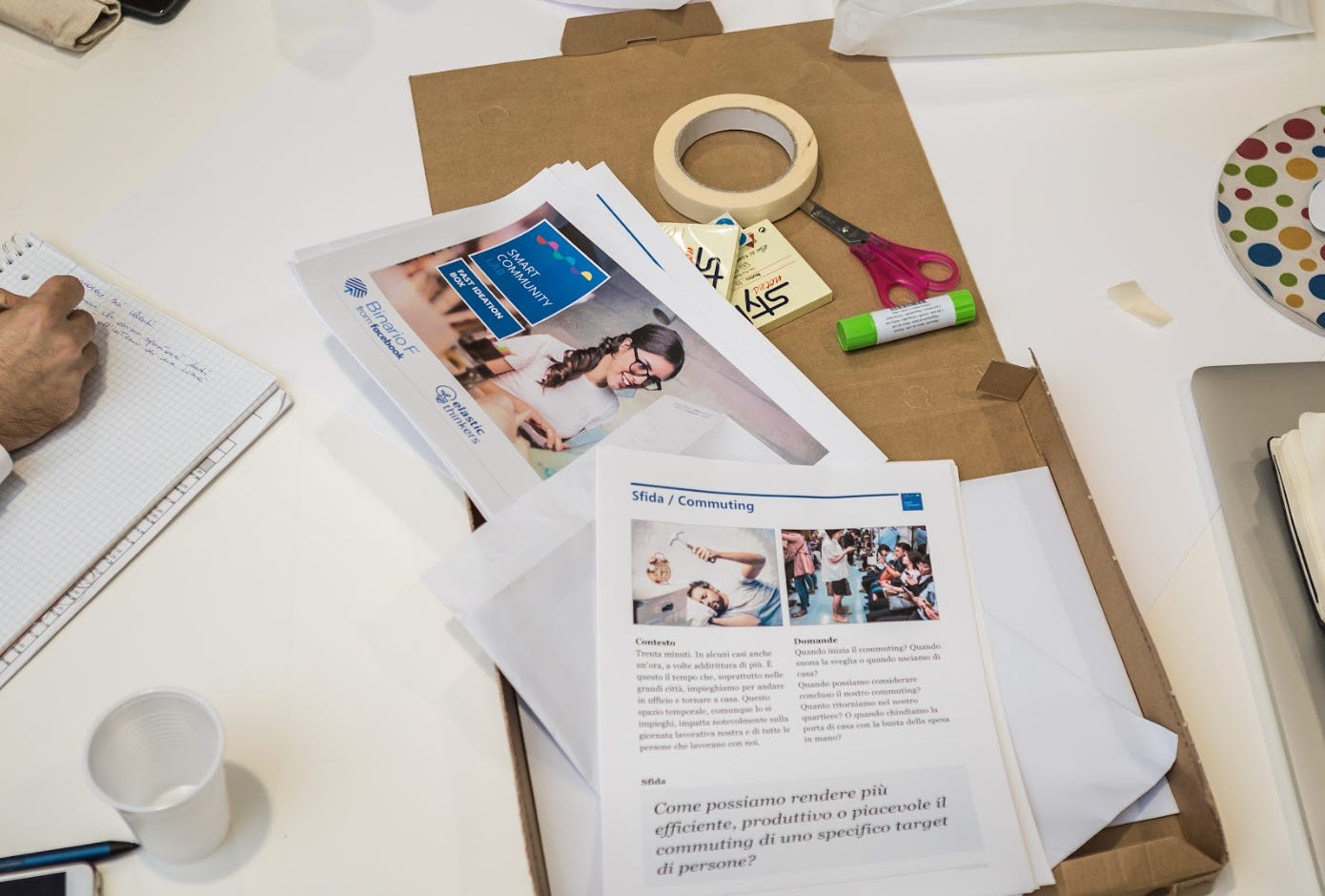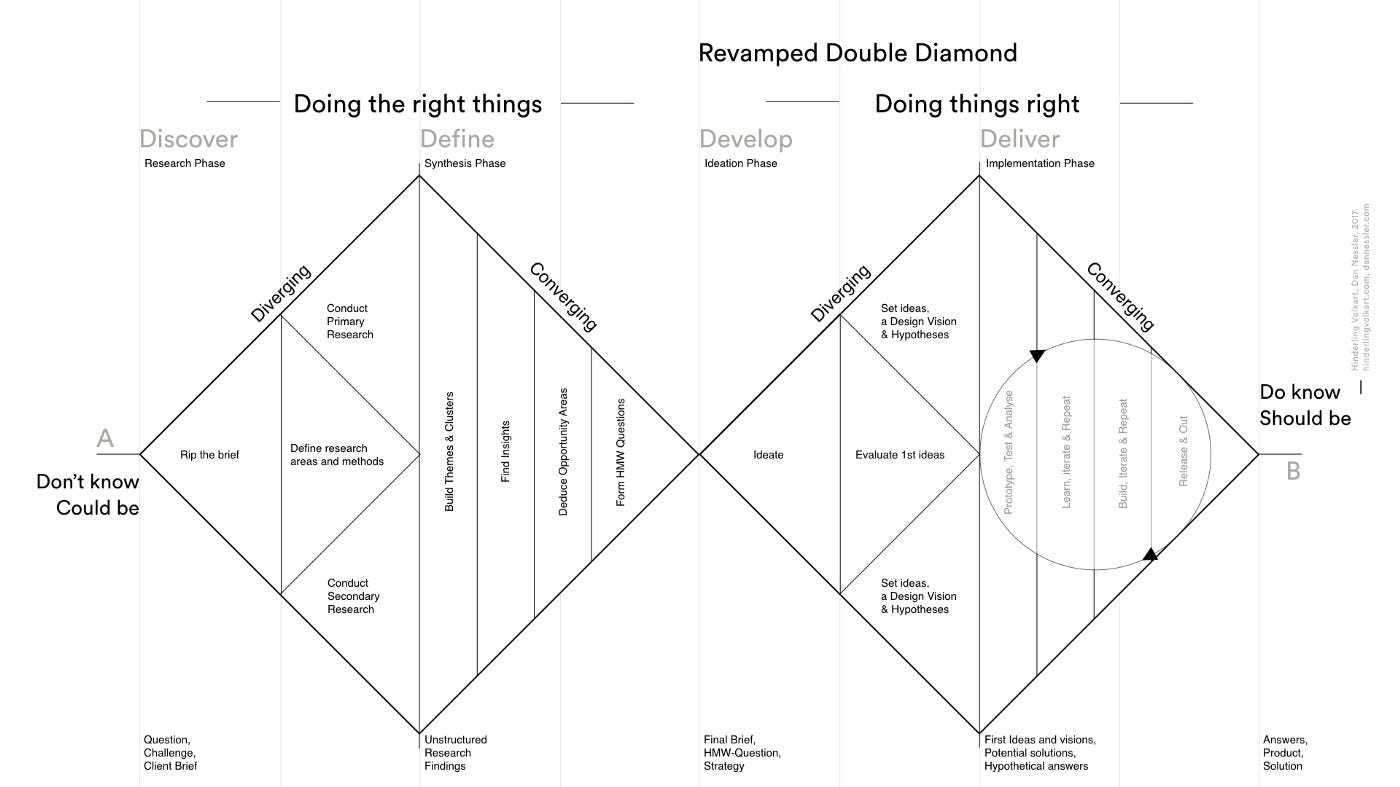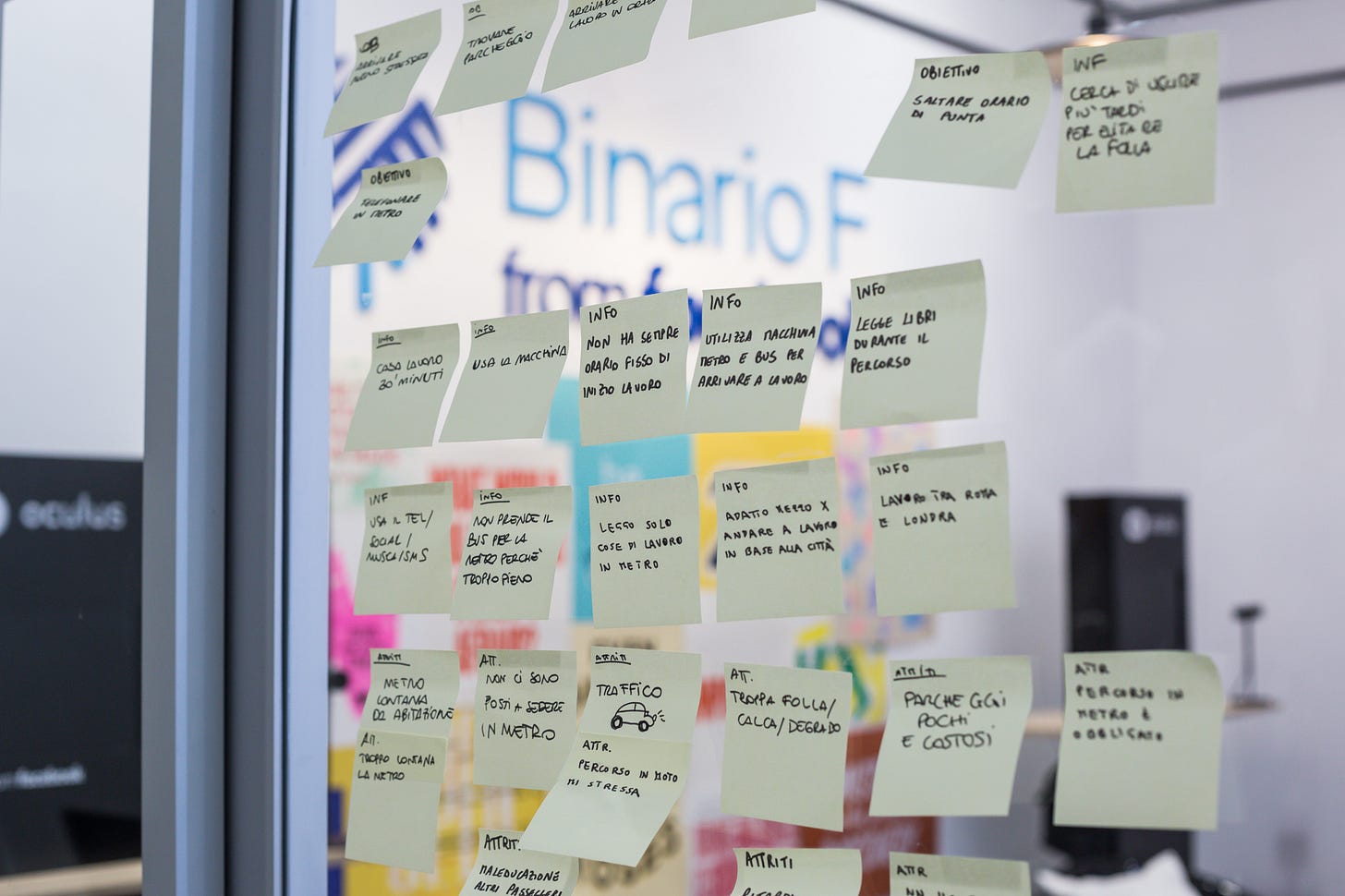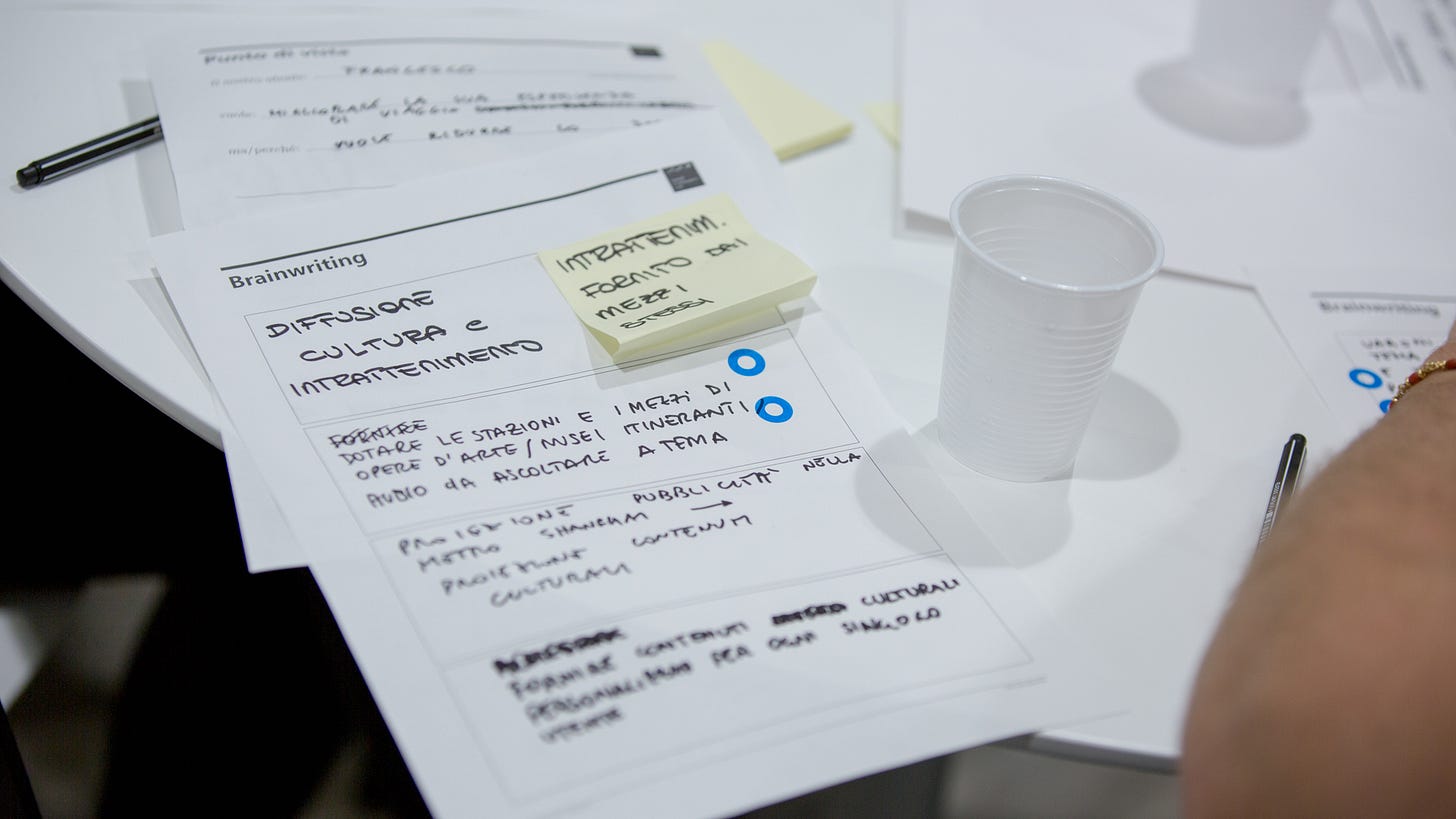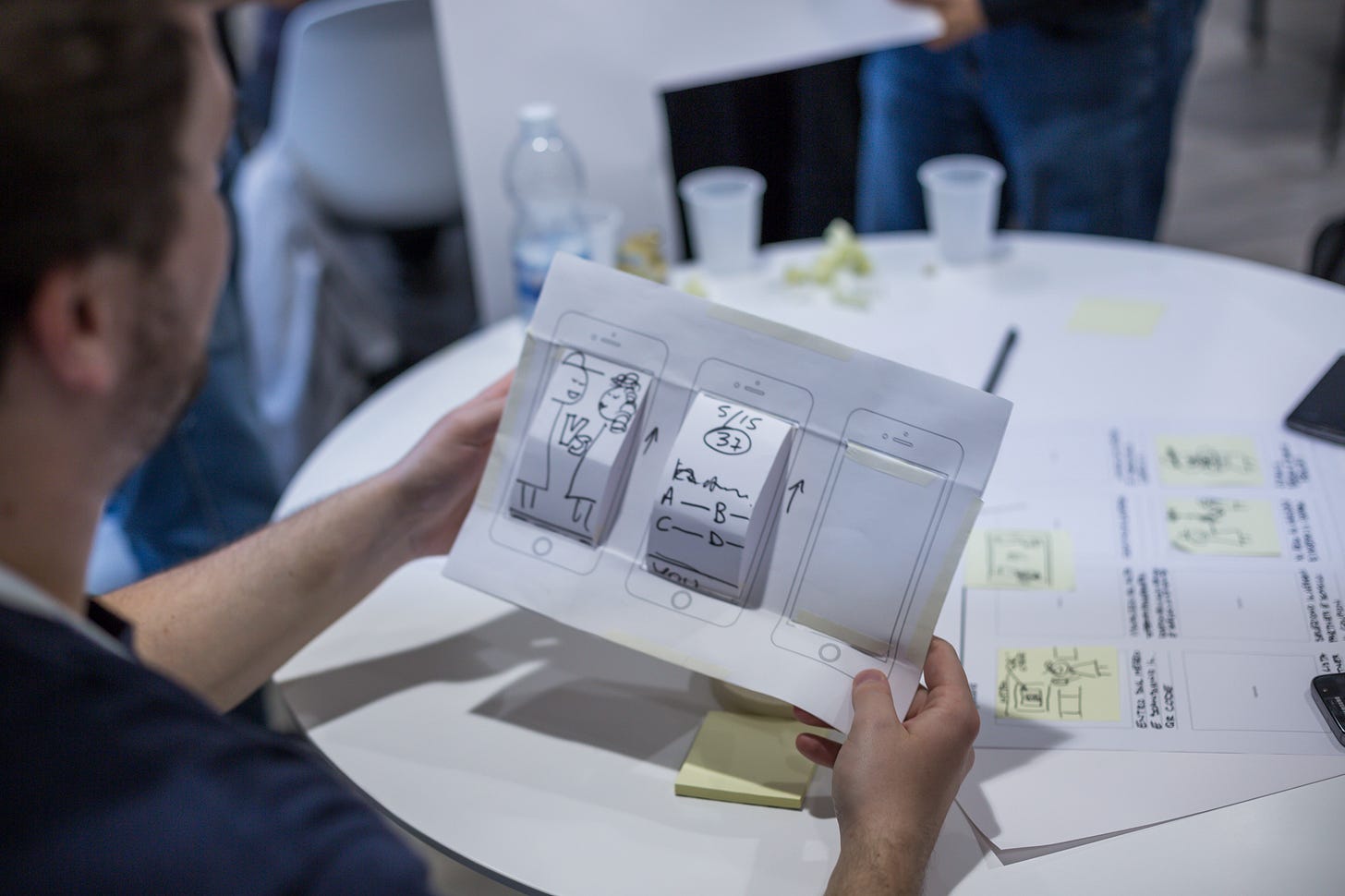Why Design Thinking is important for product managers
S02-E04 (19 February 2023)
If you were forwarded this email or if you come from Linkedin, you can sign up to receive an article like this every fortnight.
Ciao,
I am again in your inbox with a new episode of my product management newsletter. Today, I take you back to the classroom to talk about design thinking, a subject I have often taught: from corporate seminars to university courses to start-up accelerator programs. To help people understand the essentials of this user-centered design method, I also created an educational kit, the Fast Ideation Box, which came in a cardboard pizza box.
Design thinking has been declined in many versions and is a fundamental tool for any product manager. On the one hand, it helps reduce the risk of investing in developing worthless ideas. On the other hand, it helps to understand which functionalities are most important for users and which ones can be built later or not developed at all.
How design thinking works
There are many ways to illustrate the design thinking process. The d.school at Stanford University, for example, represents the phases of the process with five hexagons: empathize, define, ideate, prototype, and test.
Another very effective way to represent the process we have just described is the two diamonds.
This diagram emphasizes the nature of design steps, which may be divergent or convergent. A step is divergent when the objective is to generate as many elements as possible, conceiving and giving room for creativity or investigating and giving space for discovery. Conversely, it is convergent when the objective is to move from a large amount of information and hypotheses to a few clear, synthetic, and representative elements.
If we apply this way of interpreting the steps of the process, we see that:
The Empathize phase is divergent because it consists of acquiring as much information as possible, with various facets and various points of view, so there is divergence;
the Define phase is convergent because it consists of defining a point of view, a lens through which to look at the user's problems and objectives;
the Ideation phase is divergent because it leads to generating multiple possible solutions for a specific problem;
finally, the Prototype and Test phases are convergent in that they consist of choosing an idea, prototyping it, and presenting it to potential users.
If we represent all the steps one after the other, we see that the result is two diamonds placed one after the other; hence, the name “two diamonds.” Let's take a closer look at the steps.
1. Empathize
The design thinking process starts with a challenge, i.e., the realization that a problem or opportunity affects a group of people. We need to understand who these people are, their thoughts, how they experience the pain, and what they are already doing to solve it.
Those who will use a product are different from those who design it and therefore have different views of the world and think for themselves. The product team's opinions can be misleading and lead them astray. Better to adopt a healthy childlike attitude and ask why as if you know nothing about the subject.
Steve Blank popularised the expression get out of the building to emphasize that it is necessary to have direct contact with potential users. This approach makes it possible to discover information that would be impossible to obtain by sitting around a meeting table, analyzing statistical data, or administering telephone questionnaires.
The empathy phase is carried out through two instruments: direct observation and interviews. It is necessary to observe people and try to understand their motivations, perhaps taking photographs to have the opportunity to analyze coldly what we have seen and learned. In addition, it is necessary to conduct in-depth interviews, be curious to discover our potential users' world, and resist the temptation to propose solutions immediately.
To better understand how vital the ethnographic approach is, it may be helpful to read the book Small Data (affiliate link) by Martin Lindstrom. The author gives many examples of field research. For instance, he tells how he designed the packaging of a cereal box for an Indian brand by observing the relationship between daughters-in-law and mothers-in-law and the different color preferences of the two generations. Young Indian girls have been influenced by the western world and tend to combine the concepts of freshness and authenticity with pastel colors, while mothers-in-law still prefer very bright colors. It was, therefore, necessary to design a package that would please both generations.
These clues can only be discovered by interacting with people and carefully observing their non-verbal language. No questionnaire or statistical data can create empathy between the designer and the people he wants to help.
2. Define
In the Define phase, the objective is to examine the results of the empathy activity and transform them into insights (clues), which help us to define a point of view from which to address the problem.
Define is a convergent phase of fundamental importance because it makes all the information we have gathered explicit and organized. Typically, the work takes place in an environment with large surfaces on which we stick post-it notes. The design team goes through all the material and synthesizes the insights into short sentences they write on the post-its. These are grouped into categories that bring out patterns indicating the ne’ needs, goals, and frustrations.
At this point, it is possible to start formulating insights. For example, let us imagine that we have observed commuters walking to work in winter. Many buy a cup of coffee to take with them on the journey and hold it tightly in both hands, often bringing it close to their lips even without drinking. We can infer from this that: our user buys a hot drink to warm up on the way to work.
This insight may seem very trivial, but it is full of consequences. For example, a fully insulated container that does not transmit heat to the hands would be counterproductive. Or, I might wonder whether coffee can be replaced with another hot drink. And so on.
Usually, a good problem statement has these characteristics:
it expresses the problem clearly,
it makes it immediately clear which idea is valid and which is not,
it inspires the team,
it intrigues people outside the team to whom it is presented,
It helps generate specific solutions and does not lead to solutions that are the solution to all problems for the world.
3. Ideate
By understanding the real motivations behind people's behavior, we can formulate a design challenge and move on to the ideation phase. Design thinking encourages teamwork and sharing: by combining several ideas, there is a greater chance that the result will be better than the idea that would have come from a single person sitting in their office.
There are two things to keep in mind when discussing new ideas. The first is that many people think they are not creative. This is a mistake because we usually associate creativity with art and music. The reality is that we are all capable of creating new things, even if some are more trained than others. One of the significant advantages of design thinking is that its immediacy helps even the most “rational” individuals to imagine surprisingly creative solutions.
The second thing is that we are often afraid to come up with ideas because we are afraid that others will judge us as stupid. This is also a mistake because there is only one way to have good ideas: to have lots of ideas. All the ideas we put on the table are helpful, even those that seem improbable or stupid to us. They stimulate the creative process of other team members and allow new ideas to be built incrementally.
The ideation phase is divergent and begins with a question: How might we? For example, following our coffee example, the question might be: How might we help the customer warm up on the walk from home to work?
Once the question has been asked, one can put many ideas on the table, leaving aside all kinds of limitations and inhibitions. There are no right or wrong solutions. On the contrary, it generally helps to present even extreme solutions, such as time travel or the possession of superpowers: it is from extremes that the best ideas are born.
There are various brainstorming techniques (I like brainwriting). The aim is always to have a whiteboard full of ideas that can be grouped into categories from which specific working hypotheses will emerge that can be further studied and prototyped.
4. Prototype
The fourth stage of the design thinking process is to create prototypes using tools as simple as paper. It is a fast, cheap, and straightforward way to test an idea and understand whether the design elements meet the user’s needs, goals, and frustrations.
Prototyping is also a very effective way of continuing to generate solutions. You can think of the prototyping phase as a continuation of the ideation phase. By bringing what was previously only in your head into the real world, you will understand what makes sense and does not and what directions your idea can take.
It may seem counterintuitive, but the team must approach this activity intending to learn and not to validate ideas. Prototypes are a straightforward and effective way of gathering information from the customer.
There is no need to make a more complex prototype than a simple sheet of paper with post-it notes on it. On the contrary, the simpler and “cartoonish” the prototype is, the greater the chance of receiving honest feedback. Users will understand that the team is still in the early stages of design and is open to feedback and changes.
For tangible product prototypes, you can use cardboard, aluminum foil, plywood, foam, and any DIY material that can serve the purpose. For prototypes of web interfaces or apps, you can use paper and markers or services such as Balsamiq to make low-resolution wireframes.
The important thing is that the prototype can generate a meaningful user experience.
5. Testing
Creating prototypes makes it possible to interact with customers and observe their reactions. The testing phase, therefore, consists of returning to the dialogue with users to see whether the solution designed by the start-up creates value and is easy to understand and use.
It is essential to allocate time and effort to this activity because it represents the turning point between a new iteration of prototyping and the step toward developing an actual product.
One must be careful because one might be tempted to present a prototype trying to convince the user of the goodness of the solution. After all, it is our idea, and we have worked on it for a long time. Instead, it is crucial to approach this activity with humility, ready to receive feedback and learn.
Users may be brutal, but it is much better to learn unpleasant things at this stage rather than after a few months when the team has spent weeks on development. Making low-resolution prototypes using tools such as paper and markers is cheaper than modifying software or a product ready for production.
After testing, the team can decide whether to go back to devising and prototyping new solutions or proceed to a more operational phase of designing and developing prototypes closer to the final product.
The confidence boost you get when you see your ideas working in the field and receive valuable information on how to modify your solution will make moving on to the development phase easier and safer.
To dive deep, some YouTube videos on design (thinking):
Interesting and inspiring readings
Two books that I loved very much. The first one is Viola Ardone’s The Children’s Train, the story of the unhappy relationship between a very poor child Amerigo and his mother, Antonietta, a woman surviving in post-war Italy. Touching.
The second is Miss Eliza’s English Kitchen: A Novel of Victorian Cookery and Friendship (affiliate link) by Annabel Abbs. Based on the true story of the first modern cookery writer, the book is a spellbinding novel about female friendship, the struggle for independence, and the transcendent pleasures and solace of food. Inspiring.
Thanks for taking the time to read this episode of my newsletter: I hope I’ve been helpful. If you think my sketchbook might interest someone else, I’d be glad if you shared it on social media and forwarded it to your friends and colleagues.
See you in a couple of weeks 😊
Nicola



